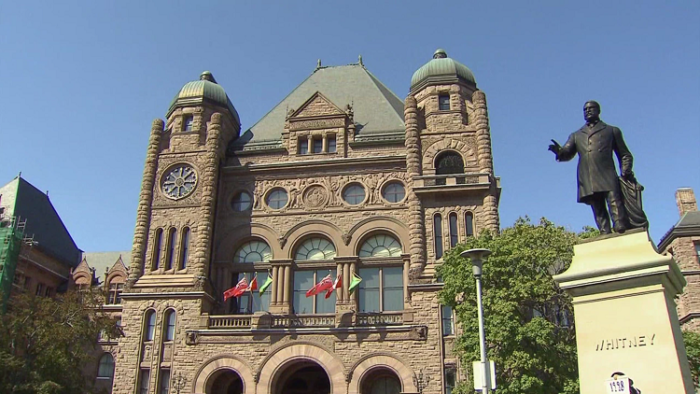UPDATED
Ontario’s finance minister has revealed a $17-billion package to support the health sector, people and businesses through the COVID-19 pandemic.
Rod Phillips was supposed to present a full budget Wednesday but opted not to in light of the outbreak.
The fiscal update outlines the ways the province is focused on the COVID-19 response and how they will help people in Ontario.
Phillips describes this as a “critical first step”.
Here are some highlights:
$7 Billion in additional spending
The province announced $3.3 billion in addition funds for healthcare of which $2.1 billion is specifically to support the COVID-19 response. They have also dedicated $1 billion as a COVID-19 contingency fund. Here’s the breakdown:
HEALTH SPENDING
- $341 million for hospital capacity to increase assessments and treatment
- $243 million for long term care home emergency capacity
- $100 million more to Public Health
- $170 million for community capacity, homecare, and Telehealth Ontario
- $62 million for health care workers in assessment centres, hospitals, and the community
- $75 million for new personal protective equipment and critical medical supplies
- $80 million for ambulance and paramedic services
- $70 million for new infection control measures in retirement homes
- The plan also includes an additional $1.2 billion to improve services in the health and long-term care sector.
The plan also provides $3.7 billion in support to people and jobs. Here’s a look at the new measures:
SENIORS
- $75 million in urgent additional support for 194,000 low-income seniors by proposing to double the Guaranteed Annual income System maximum payment to $166 per month for individuals and $332 per month for couples, for six months starting April 2020
- Coordinating subsidized deliveries of meals, medicines and other essentials at cost of $5 million
PARENTS
- Province will help pay for extra costs associated with school and daycare closures during the pandemic by providing a one-time $200 payment per child up to 12 years of age, and $250 for those with special needs including kids enrolled in private schools. There will be an application portal live by April 6 to access payments. The province encourages people to choose the electronic transfer option as it is the easiest way to get the money as soon as possible. It’s a program that will cost the province $340 million.
STUDENTS
- There will be six months of OSAP loan and interest accrual relief, in coordination with the federal government’s measures
INDIGENOUS PEOPLES
- $26 million to Indigenous peoples and communities which include emergency assistance for urban Indigenous people in financial need, costs for health care professionals and critical supplies to reach remote First Nations, as well as funding to address emergency planning and self-isolation needs
HELPING THE VULNERABLE
- $200 million in new funding to provide temporary emergency support for people in financial need as well as funding to municipalities and service providers like food banks, homeless shelters, churches, and emergency services.
- $148 million for food banks and homeless shelters
ELECTRICITY BILLS
- $9 million in direct support to families for their energy bills by expanding eligibility for the Low-income Energy Assistance program and ensuring their electricity and natural gas services are not disconnected for nonpayment during the COVID-19 outbreak.
BUSINESSES
- Cutting taxes by $355 million for about 57,000 employers through a proposed temporary increase to the Employer Health Tax exemption. 30,000 more employers would not pay any EHT for 2020. This will apply to companies with $1 million dollars (or less) in payroll.
- Help support regions lagging in employment growth with a proposed new Corporate Income Tax credit- The Regional Opportunities Tax Credit
$10 billion in cash flow through tax and other deferrals:
- The government will provide a 5-month interest and penalty-free period to make payments for the majority of provincially administered taxes providing $6 billion in relief to help support Ontario businesses when they need it most
Minister Phillips also announced the province will defer the upcoming quarterly (June 30) property tax payments municipalities make to school boards by 90 days. This will provide municipalities to provide property tax deferrals of over $1.8 billion to local residents and businesses
They are also providing $1.9 billion in new financial relief by the Workplace Safety and Insurance Board (WSIB) allowing employers to defer payments for a period of 6 months.
The fiscal update provides an unprecedented $2.5 billion in reserve – the largest in Ontario’s history – to provide continued flexibility during this difficult time. They have two contingency funds totaling $2.3 billion.
The government projects a deficit of $9.2 billion for 2019-2020 rising to $20.5 billion in 2020-2021. At this time, there is no scheduled plan to balance the books. This will be projected when the full budget is announced later this year.
Phillips says the province’s plan is in place to compliment the $82-billion financial aid package introduced by the federal government.
Several initiatives have already been announced including $304 million to support immediate needs to healthcare, $200 million for social services and immediate changes to hydro rates for 45 days.
Late Wednesday afternoon, the Ontario Legislature met for an emergency sitting to pass the bill. Respecting physical distancing, there were only 28 members of Provincial Parliament in the Chamber including 14 PC MPPs, eight NDP, two Liberal, two Independents, Green Party Leader Mike Schreiner, and the Speaker.
The Legislature will adjourn until 1 p.m. on April 14.
The full 2020-2021 budget is expected to be introduced by November 15.
Nicole Martin interviewed Rod Phillips about the $17B financial aid package


